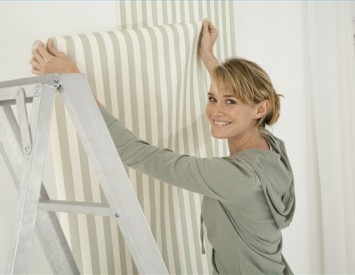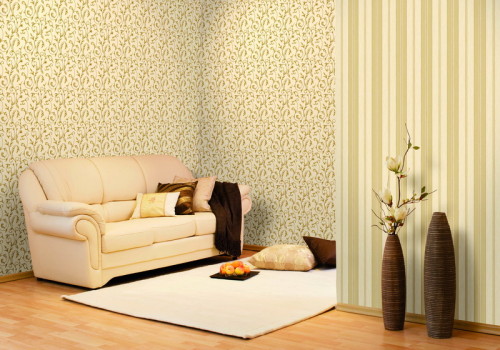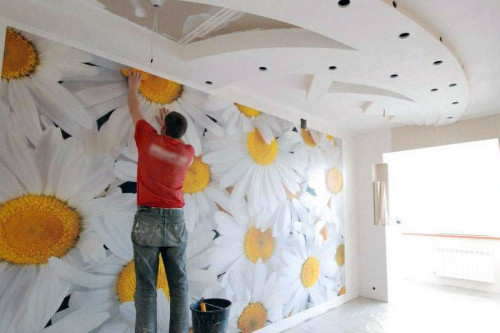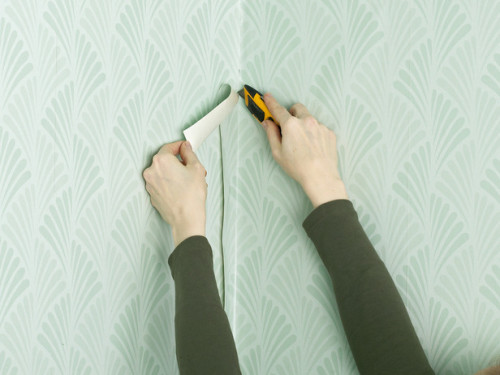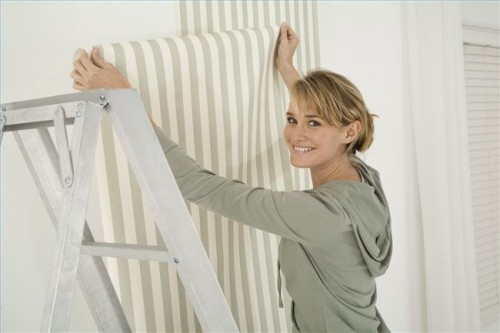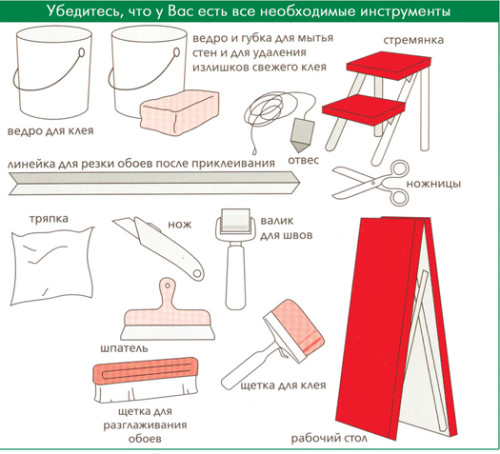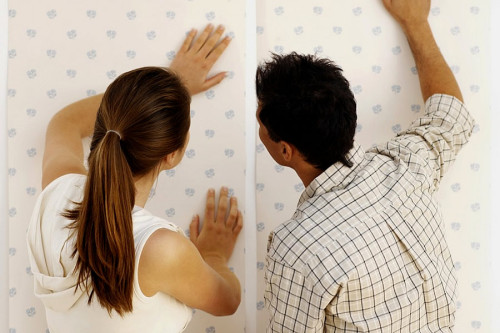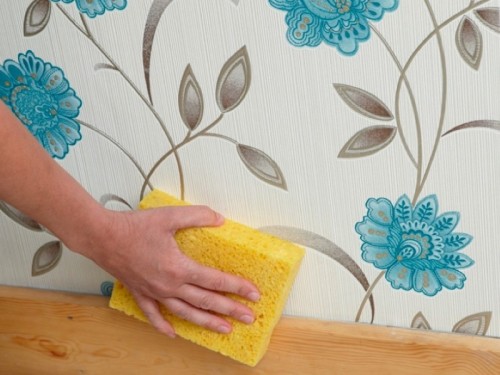Wallpaper is rightfully considered one of the most popular finishing materials for walls in any room. The speed and ease of installation, as well as the ability to make an interesting design due to a variety of prints, became the cause of their popularity. Using wallpaper in one day, you can fundamentally change the appearance of the walls, without spending large means on it.
Content
Types of wallpaper
At this time, there are a large number of different types on the wallpaper market:
- Textile wallpaper.
- Liquid wallpaper.
- Vinyl wallpaper.
- Paper wallpaper.
- Wallpaper.
- Glass wallpaper.
- Wallpaper "for painting."
- 3D wallpaper.
- Raufazer.
Each of these finishing materials differs not only in its appearance, but also by the basis that affects their quality and resistance, as well as the features of gluing.
By resistance to moisture, the wallpaper is divided into:
- Moisture resistant. On the tags in such wallpaper, the marking B-0 or B-1 is indicated. They differ in that their surface is resistant to abrasion under the influence of moisture, but without the use of chemical detergents.
- Washes. Designation B-2, B-3, B-4. Such wallpaper, as follows from their name, can be washed. Their surface has a special structure, which is able to withstand the effects of various detergents without loss of original species. As a rule, such wallpaper is used in more passing places where the probability of pollution is quite high. It can be an entrance hall, a kitchen or even a children's room for a small child who is guaranteed to “experience” them with felt -tip pens, paints and children's porridge.
- Inexhaustible. S-1 marking. As a rule, so the wallpaper on a paper basis. If moisture gets, they soak and lose their integrity of their surface. These wallpaper cannot be used in places of moisture concentration, such as a bathroom or kitchen. Since they cannot be washed, it is better not to glue them in passable rooms, since they will quickly become unusable.
Vinyl wallpaper and their types
Vinyl wallpaper is one of the most popular types of this finishing material. The choice of colors and the difference in textures make them an excellent option for decorating any room. This is one of the most moisture -resistant materials, most of them are perfectly washed even with the use of detergents.
Vinyl wallpaper got their name thanks to their structure. It consists of 2-layers. The first is the basis, can be made from fabric, simple paper or non -woven. Glue is applied to it when gluing. The outer layer is made of polyvinyl chloride (or just vinyl).
Vinyl wallpaper can be conditionally divided into several types. Such a classification depends on the type of PVC coating used.
- Coating made of foamed vinyl. This is one of the most popular types of vinyl wallpaper. Due to the use of foamed PVC coating, they pass the air to the wall well, allowing it to “breathe”. However, their upper structure has large pores that can pass moisture, damaging the wallpaper, therefore, it is necessary to treat them carefully, without using abrasive cleaning agents.
- Vinyl wallpapers with silkography. Thanks to the use of synthetic fibers imitating silk, the appearance of these wallpaper looks very attractive. Moreover, in comparison with textile wallpaper, their price is much lower. The transfusion of their surface with a mother of pearl in the sun can make the interior in the room quite interesting.
- Washing wallpaper. Thanks to the dense vinyl structure, with microscopic pores, such wallpapers tolerate the washing with detergents and cleaning with a brush. Unlike coating from foamed vinyl, washing wallpapers have mainly a smooth structure without a particularly noticeable relief. Such material is an ideal solution for the kitchen.
- Wallpaper with solid vinyl coating. Such wallpapers differ in that they pass the air well, despite the dense coating, and also practically do not swell when applying glue. It is worth noting that this material is relatively new in the market and its price is still quite high.
The advantages of vinyl wallpaper include:
- Moisture resistance. Although their various species react differently to moisture, in this regard they are more preferable than other types of wallpaper.
- Due to its density, thickness and structure, vinyl wallpaper can easily hide small defects in the surface of the wall.
- Vinyl coating is perfectly forming, so it is possible to apply any pattern and any structure to such wallpapers. They can be imitated under a brick, torn stone, tiles, wood, etc.
Of the disadvantages, poor breathability can be distinguished. Due to which moisture can accumulate under their basis and mold and fungus form. When applying glue, vinyl wallpaper swell and stretch, so they must be glued accurately.
How to paste vinyl wallpaper
Materials
To start working on gluing vinyl wallpaper with your own hands, you need to prepare tools and materials:
- Wallpaper.
- Wallpaper glue. Be sure to read the instructions for the glue. It should be intended specifically for such wallpapers. The fact is that cheap glue, which is perfect for paper paintings, may not withstand heavy vinyl weights. Often, novice craftsmen ask the question: is it possible to glue vinyl wallpapers with non -woven glue. Such glue can be glued to any kind of vinyl wallpaper, both on paper and on a non -woven basis.
- Spatula for straightening the paintings.
- A roller or a wide brush for applying the adhesive to the surface of the wall and wallpaper.
- Wall surface primer brush.
- Chancellery knife for cutting canvases.
- Small brush for smearing joints.
- Rubber roller for rolling joints.
- Line and level.
Wall preparation and wallpaper gluing
Playing order:
- Before starting work on gluing wallpaper, it is necessary to prepare the walls. They are cleaned of the remnants of old wallpaper. All problem areas are putting with the finish putty and wiped with a special net.
- After that, the wall must be primed. To do this, use a deep penetration primer. It penetrates the structure of the plaster and binds its grains, not allowing its parts to exfoliate. For the primer, a brush with a soft pile is used so that when applying, it penetrates deeply inside the wall. The solution should not be “sorry”, here you can use the principle of “the more” the better.
- In the summer, the primer dries quite quickly, so gluing work can be done on the same day. If it is assumed to use detergents that pass the air poorly, then before starting the wall gluing it is better to process with a special composition that will prevent mold or fungus.
- The main rule of how to properly glue vinyl wallpaper is the dryness of the walls. It is impossible to carry out work on wet walls. In order to check the moisture content of the surface, you can glue a small piece of polyethylene overnight at night, and then check its condition in the morning. If the wall is dry, it will be dry under polyethylene. Otherwise, drops of moisture can be seen on the surface of the wall. It is impossible to glue vinyl wallpapers on such a wall, they will not have time to dry and can slide from the surface of the wall.
- We begin to cook glue. Its packaging indicates a consistency for each type of wallpaper. It is necessary to clearly adhere to the indicated proportions in order not to spoil the expensive material. If there is not enough time to glue the whole room, it is better to cook a small batch of glue, because it cannot be stored for a long time.
- Preparing glue is very simple. Dry glue is gradually adding to the water at room temperature constantly stirring. In order for the solution to be uniform without lumps, you can use a drill and an industrial mixer. The drill is exposed at minimum speeds so as not to spray the glue on the floor. Gradually, the composition will solidify, turning into a mass close to jelly. It is necessary to leave it for about 1 hour and after that you can start work.
- Let us further consider how to glue vinyl wallpaper with your own hands. Initially, it is necessary to measure the distance from the upper baguette to the bottom of the wall. This will be the length of one strip. If you can’t guess to a millimeter, do not despair, the lower part of the wall will still be closed by the skirting board.
- You should start with the visible corner, which is diagonally to the entrance to the room. This is the most noticeable place in the room. To stick the first strip evenly, it is necessary to draw a vertical line over the entire wall in terms of level.
- A cut strip of wallpaper is laid on a clean surface. To do this, you can use the rolls of old wallpaper. In this case, the floor will remain clean, and it is not necessary to carry out the cleaning, it is enough only to curtail and throw out the old wallpapers smeared with glue.
- The strip on the surface is laid so that the litter comes out from under the wallpaper. This is necessary to smell the joints well. The strip of wallpaper is lubricated with glue thoroughly, without leaving dry places. Otherwise, it will not tightly stick to the wall.
- A very important point is how to glue vinyl wallpaper on a non -woven basis - at a temperature of the room below +18 ° C, the canvas cannot be glued. Be sure to read the specification for this type of wallpaper. The fact is that when gluing some of them, it is necessary to lubricate only the back of the wallpaper, and for some it is necessary to lubricate the surface of the wall.
- The smeared strip is carefully folded in such a way that the front side is not smeared and, having glued the upper hand, is carefully laid out in the direction of the floor.
- After that, the wallpaper is smoothed with a spatula, so that there are no air bubbles left under them. The movements of the spatula should resemble a Christmas tree, that is, from the center down to the edge. After that, the junction rolls the junction. Vinyl wallpapers glue the "joint in the joint" without overflow.
During work and after their end, it is necessary to exclude drafts in the room. At this time, you can not use air conditioning or fan. Otherwise, the wallpaper can be “swollen”, and they will have to be changed. After the glue dries, a little backward places are smeared with a small brush and rolled again with a roller. If the wallpaper strip is greater than the desired length, it can only be cut after drying.
